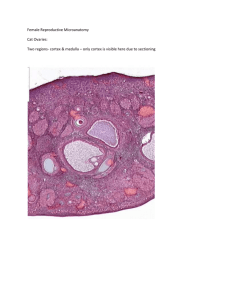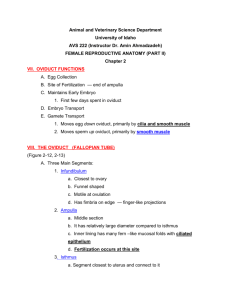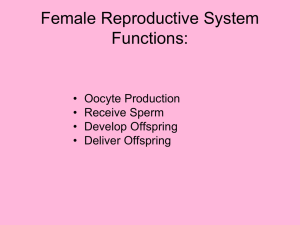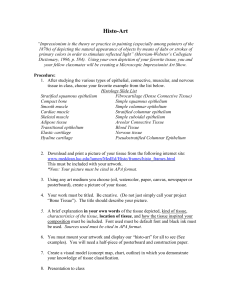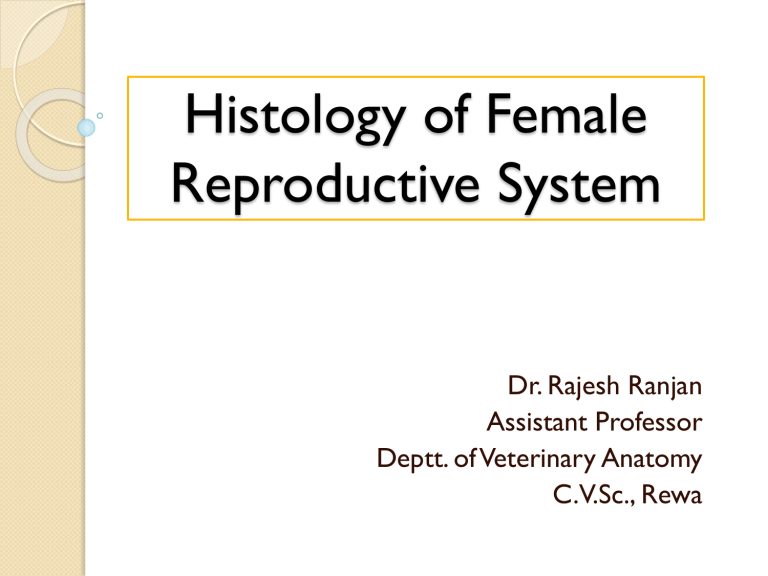
Histology of Female Reproductive System Dr. Rajesh Ranjan Assistant Professor Deptt. of Veterinary Anatomy C.V.Sc., Rewa Female Reproductive System ▪Ovaries ▪Oviducts ▪Uterus ▪Vagina ▪Vulva Ovaries Ovoid structure divided into outer cortex and inner medulla. Cortex ( outer portion) ◦ Broad peripheral zone containing follicles in various stages of development embedded in loose connective tissue stroma and covered by Germinal epithelium which is Simple cuboidal/ columnar (young) and low cuboidal/ squamous (adult). ◦ Stroma: supporting tissue and covered by Tunica albuginea just beneath the germinal epithelium. Medulla (Inner portion) ◦ Contains nerves, blood vessels, lymphatics, loose connective tissue and smooth muscles. ◦ Also contains rete ovarii which is a solid cellular cords or networks of irregular channels lined by cuboidal epithelium. Ovarian Follicles Primordial follicle: ◦ Unilaminar, preantral, resting follicle. ◦ Comprises of primary oocyte surrounded by simple squamous epithelium. Primary follicle: ◦ Unilaminar, preantral, growing follicle. ◦ Comprises of primary oocyte surrounded by simple cuboidal epithelium. Early Secondary follicle: ◦ Multilaminar, preantral, growing follicle. ◦ Comprises of primary oocyte surrounded zona pellucida and stratified epithelium of polyhedral/ follicular cells called as Granulosa cell. ◦ Zona pellucida is a glycoprotein layer. Late Secondary follicle: Multilaminar, antral, growing follicle. • Comprises of primary oocyte surrounded by zona pellucida and stratified epithelium of polyhedral/ follicular cells called as Granulosa cell (Zona Granulosa) with an outer covering of theca interna. • Antral pockets are formed containing liquor folliculi. • Theca layer (Theca interna) comprises of vascularized multilaminar layer of spindle shaped stroma cells. • Graafian follicle: Also called Vesicular/ Tertiary follicle. Multilaminar, antral, growing follicle. Comprises of primary oocyte surrounded by Zona pellucida, Granulosa cells (Stratum granulosum) with Antrum and Theca layers. Primary oocyte is spherical with centrally located nucleus having sparse chromatin network and prominent nucleolus. The primary oocyte lies in the accumulation of granulosa cells known as Cumulus oophorus. The innermost cell layer of cumulus oophorus immediately surrounding the oocyte becomes columnar and radially disposed called Corona radiata. Antrum is filled with liquor folliculi. The granulosa cells form a parietal follicular lining, the Stratum granulosum. ◦ It comprises of polyhedral cells (basal layer may be columnar). Some of the granulosa cells may contain large PAS-positive inclusions called the Call-Exner bodies which represent intracellular precursors of liquor folliculi. Theca layers: comprises of Theca interna (inner vascular layer) and Theca externa (outer fibrous layer). Cells in the theca interna are spindle shaped with delicate reticular fiber network. Theca externa is loose connective tissue layer with fibrocytes arranged concentrically around the theca interna. Graafian follicle Graafian follicle at higher magnification Corpus luteum: At ovulation, the follicle ruptures, collapses and shrinks. There is infolding of the follicular wall and forms Corpus hemorrhagicum as blood gets accumulated into the antrum. After that there is vascularization from the tunica interna and the granulosa cells enlarge, luteinize and forms the large luteal cells. The theca interna cells form the small luteal cells. This leads to the formation of Corpus luteum. The first sign of luteal regression is seen in late diestrus and involves the condensation of lutein pigment, which then appears reddish, followed by fibrosis and resorption of the corpus luteum. The connective tissue scar remaining after luteal regression is called Corpus albicans. Corpus hemorrhagicum Corpus albicans Corpus luteum Oviduct: Also called fallopian tube or uterine tube. Oviduct has three parts: ◦ Infundibulum ◦ Ampulla ◦ Isthmus The lining epithelium is Simple columnar/pseudostratified columnar with motile cilia. Both ciliated and nonciliated cell types possess microvilli. Lamina muscularis is absent. Lamina propria-submucosa consist of loose connective tissue with many plasma cells, mast cells, eosinophils. In ampulla, the tunica mucosa is highly infolded forming primary, secondary and tertiary folds, while in isthmus region only primary folds are present. Tunica muscularis comprises of inner circular smooth muscles with isolated bundles of longitudinal and oblique muscle fibers. Tunica serosa is reflection of peritoneum having fibrous tissues covered by mesothelium. Numerous blood vessels and nerves are also present. Histological layers of Oviduct Arrow indicates Pseudostratified columnar epithelium with motile cilia. Uterus: Uterus has three parts: Two horns or cornua, Body or corpus and Neck or cervix Histological structure of cornua and corpus: Endometrium (Tunica mucosa and submucosa) The lining epithelium is ◦ Simple columnar in mare, bitch, queen. ◦ Simple columnar/ pseudostratified columnar in sow, ruminants. Lamina propria- submucosa is divided into sub-epithelial functional zone that comprises of richly vascular L.C.T. with many fibrocytes, macrophages, mast cells, etc and a deep part comprising of L.C.T. and simple coiled branched tubular glands. These glands are absent in caruncular areas in ruminants. Uterine glands are lined by ciliated and non-ciliated simple columnar epithelium. Myometrium (Tunica muscularis): Consists of thick inner circular layer and outer longitudinal layer of smooth muscles. In between these two layers stratum vasculare is present. Perimetrium (Tunica serosa): Consists of L.C.T. covered by mesothelium, few smooth muscle cells, lymphatics, blood vessels and nerves. CE- Columnar epithelium, UF- Uterine fold,TG- Tubular gland Cervix (Neck of uterus): Thick walled, muscular tube rich in elastic fibers. The mucosa-submucosa forms high primary, secondary and tertiary folds. The lining epithelium is simple columnar with many mucigenous cells including goblet cells. Lamina propria-submucosa contains dense irregular connective tissue with collagenous and elastic fibers. Intraepithelial and simple tubular glands are present in ruminants. Uterine glands do not extend into the cervix. Tunica muscularis consists of Inner circular and outer longitudinal muscle layers. Elastic fibers are prominent in the circular layer. Tunica serosa contains loose connective tissue covered by mesothelium. Vagina: Muscular tube with flat longitudinal mucosalsubmucosal folds throughout the its length. It is lined by stratified squamous non-cornified epithelium. The number of goblet cells is variable in different phases of estrus cycle. Lamina propria consists of loose or dense irregular tissue and richly supplied by blood vessels with few lymph nodules. Submucosa is continuous with lamina propria. Tunica muscularis consist of smooth muscle fibbers arranged in two or three layers as inner circular, middle longitudinal and outer circular. Tunica serosa (cranial part) consists of loose connective tissue covered by mesothelium and Tunica adventitia is present in the caudal part. Vulva: Also called vaginal vestibule. Extends between external urethral orifice to the vulvar lips. Histology same as vagina except for the presence of more sub epithelial lymphatic nodules. Blood vessels, cavernous tissue, venous plexus and lymph vessels are abundant in the vestibular wall. The inner surface is lined by the stratified squamous epithelium. Major vestibular glands are bilateral compound tubulo-acinar mucous glands in the propria-submucosa. The minor vestibular glands are bilateral small branched tubular mucous glands in the mucosa. The clitoris comprises of erectile tissues. The labia vulvae is covered by skin with hairs, sebaceous and sweat glands. Assignment Well labelled histological representation of female genitalia of different species of animals in practical notebook. Thanks!
